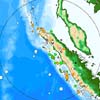 |
San Diego CA (SPX) Mar 26, 2007 Identification of the oldest preserved pieces of Earth's crust in southern Greenland has provided evidence of active plate tectonics as early as 3.8 billion years ago, according to a report by an international team of geoscientists in the March 23 edition of Science magazine. The finding pushes back the date of continent-forming processes previously determined as 2.5 billion years ago to a much earlier era considerably closer to Earth's formation some 4.5 billion years ago. Geochemical analysis of rocks has previously suggested an earlier date for plate tectonics, but this is the first study to find physical evidence of tectonics among Earth's oldest known rock structures, according to Hubert Staudigel of Scripps Institution of Oceanography at UC San Diego. "The fact that this rock structure is so well preserved is particularly lucky," Staudigel said. "The materials were formed as seafloor along a spreading center and accreted to a continental plate and just stuck there, surviving almost unscathed for as long as 3.8 billion years." The study focuses on an area near the southwestern coast of Greenland where there is a rare outcrop of ancient rock, called the Isua Supracrustal Belt, which have been dated at 3.8 billion years old. The Isua rocks are ophiolites, which have a green hue from the chlorite minerals within them and are found in all major mountain belts, usually located in areas associated with volcanism and plate tectonics. The Isua deposits were first described in the 1960s. They also have been found to contain fossilized evidence of the earliest bacterial life on Earth, also about 3.8 billion years old, in studies conducted in 1999 by Minik Rosing. The new study reveals the geological structure at Isua contains both seafloor pillow lavas and dikes, or sheets, of basalt that intruded into the pillow lavas after they formed. These features and the chemistry of the ophiolites indicate that the area was formed as the result of seafloor spreading, according to lead author Furnes. Even though the rocks have physically changed over time, it is still possible to see their original characteristics because of the preservation of fine-grained crystals that show they were cooled by contact with surrounding colder rocks, Furnes said. "To what extent one is able to see an original structure in a highly deformed rock depends basically on the experience of the observer," Furnes said. "In our case we knew what we were looking for, and all of us who did the field work have reasonably good experience with identifying pillow lavas and associated dikes." The finding of ophiolites in the oldest known rock structures leads the scientists to believe that such rocks have formed throughout Earth's nearly 4.5 billion year history, according to de Wit. "Our work shows that some form of seafloor spreading and oceanic crust formation occurs as far back in history as geological records go," de Wit said. Rosing said, "Our paper describes large-scale structural relationships that show the ancient oceanic crust was comparable to the modern crust in its structure and composition and that a section of ancient oceanic crust could be preserved by uplifting onto stable crust, similar to how more modern ophiolite complexes have formed." The paper also sheds light on the ongoing debate about the oxygen isotope composition of seawater through geological time periods. The reactions of seafloor and seawater largely control the ocean's oxygen isotope makeup, but scientists have been polarized between those that maintain the oxygen isotope content has remained relatively constant and those that argue for variation. According to Muehlenbachs, this work shows that the early ocean had the same or slightly heavier oxygen isotope composition as that of the modern ocean. "We can conclude from the oxygen isotope analyses of the pillows and dIkes that the earliest ocean had already chemically reacted with the seafloor," Muehlenbachs said. "This has great implications to the historical chemical composition of the oceans and may have played a role in the evolution of life." The geological processes of the early Earth were largely responsible for the distribution of elements throughout the land, air and oceans, having fundamental consequences for the development of life, according to Staudigel. He said the science team was sampling the Isua Supracrustal Belt looking for chemical or isotopic traces of life in the pillow lavas when they realized the area supplied geological structures proving plate tectonics from the earliest history of Earth. The Norwegian Research Council, the Nordic Center for Earth Evolution, GeoForschungsZentrum Potsdam, Agouron Institute and the National Sciences and Engineering Research Council of Canada provided funding for the research. Coauthors of the report are Harald Furnes of University of Bergen, Norway; Maarten de Wit of University of Cape Town, South Africa; Minik Rosing of the University of Copenhagen, Denmark; and Karlis Muehlenbachs of the University of Alberta, Canada. Related Links University of California - San Diego When the Earth Quakes Tectonic Science and News
 Troy NY (SPX) Mar 26, 2007
Troy NY (SPX) Mar 26, 2007The 2004 Sumatra-Andaman earthquake and resulting tsunami are now infamous for the damage they caused, but at the time many scientists believed this area was unlikely to create a quake of such magnitude. In the March 23 issue of the journal Science, a geophysicist from Rensselaer Polytechnic Institute urges the public and policy makers to consider all subduction-type tectonic boundaries to be "locked, loaded, and dangerous." |
|
| The content herein, unless otherwise known to be public domain, are Copyright Space.TV Corporation. AFP and UPI Wire Stories are copyright Agence France-Presse and United Press International. ESA Portal Reports are copyright European Space Agency. All NASA sourced material is public domain. Additional copyrights may apply in whole or part to other bona fide parties. Advertising does not imply endorsement, agreement or approval of any opinions, statements or information provided by Space.TV Corp on any Web page published or hosted by Space.TV Corp. Privacy Statement |